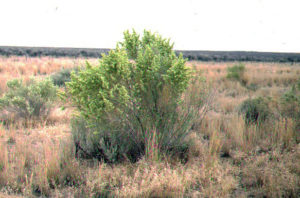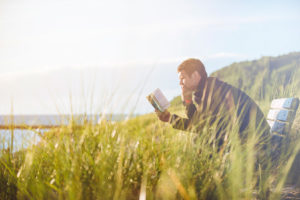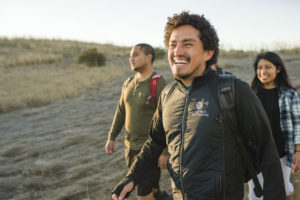Jose Gonzalez remembers a childhood spent in a small Mexican town, playing along riverbeds and tending to crops with his grandfather. When he moved with his family to the Central Valley at age 9, his love for the outdoors translated to summer camps and trips to the national parks in his new home. In college, Gonzalez helped lead instructors for a migrant youth environmental education program. He remembers an instructor he supervised asking him, “Jose, I want to go into outdoor education as a career. Who do I talk to? How do I apply? Who do I connect with to make this happen?” Gonzalez realized he wasn’t sure and that there wasn’t a Latino-specific organization he could recommend. In 2013, after obtaining his master’s in natural resources and environment, Gonzalez founded Latino Outdoors to solve that need. Today, the nonprofit group works on community outreach, outing organization, and connecting Latino professionals.
Lexi Pandell: How do you define the Latino community?
Jose Gonzalez: The Latino community is so complex. For us, the definition covers self-identified Latinos, Latinas, Chicanos, Chicanas, Hispanos, Hispanas; by nationality if they’re of South American, Central American, or Mexican descent; Mexican immigrants or those with a pronounced indigenous identity; if they are solely Spanish speaking or if they’re bilingual.
LP: Where is Latino Outdoors based?
JG: We are in the Bay Area, in the North Bay and East Bay. We have a presence in Humboldt, in the Sacramento area, in the Central Valley in Modesto, and in L.A. We’re working on expanding in the South Bay and Fresno, as well as establishing ambassadors nationwide.
LP: What do you see as some of the barriers for getting Latinos involved in nature?
JG: Transportation is a barrier for segments of the Latino community, not all. But it has come up again and again. We’ve found that families can carpool, and we can help with gas or mileage reimbursement since it’s a household cost or we provide transportation that can accommodate families. Many use public transportation, so also helping identify the gaps in public transportation to access open spaces helps a lot.
Communities may not know what resources are near them or the regulations and norms expected, thus there may be a lack of welcome or invitation. Some organizations do not understand how some communities already are engaging with open spaces and how to build on that, rather that just trying to make a community fit to an expectation of how they think an open space should be enjoyed. This includes having staff within parks and organizations that have a cultural understanding. Sometimes that means using Spanish, but also just having staff with a common upbringing or cultural connections. This is not to say you cannot bridge these connections if you are not from the community—it is just that it is quicker when you do. For example, if you know there are families using a space for social events or a quinceañera, that is an opportunity to celebrate, to see how to welcome them back, to ask why they like the space and if they know how the space is managed. Other times, families may be used to having rangers interact with them only from an enforcement perspective. Don’t do this, don’t do that, you’re not following this rule. So it reinforces seeing a uniform as something to avoid rather than to engage with.
LP: What are some common misconceptions about Latino Outdoors as an organization or the community you work with?
JG: There is the misunderstanding that the name Latino Outdoors is exclusive. We are definitely not. We’re trying to do outdoors for all, outdoors for everyone. There’s a question of why there is a need for a Latino specific outdoors organization. The answer to that is that it’s meant to be an inclusive starting point. We are proud that we are Latino-led but we are not saying this is just solely by Latinos for Latinos. It recognizes that different communities have had different challenges. It’s about having an inclusive starting point for communities to identify, which we can use to work on intra-community building, and then we can work on inter-community building. We’re all trying to move forward in the same direction.
Generally, there’s a question of: Do Latino communities care about the environment and outdoors? Are they engaged? All that is put to rest. The answer is yes. We can point to polls about how Latino communities care about the environment and conservation. Now, it’s about whether those doing the connection are aware of how Latinos connect with the outdoors and how can we bridge those gaps. It could be a misunderstanding how the Latino community is already experiencing the outdoors, and how that can be used that as a building point for other activities. If we already know some Latino communities have family picnics at regional parks, it’s not that Latinos only care about having family outings at the regional park. But if you know that may be a place to meet them and have a conversation, you can build that to overnight camping trips. And you can address issues families might have by being attuned to cultural markers. For example, it may be more difficult for daughters to be let go for an overnight trip. Parents may be concerned about safety. It may be a question of accommodating the whole family that wants to go on a trip, including grandma and grandpa.
LP: Is there anything about the Bay Area that makes it unique in terms of outreach and access?
JG: The Bay Area is a wonderful opportunity and challenge. It’s rich in diversity, resources, and opportunities. We have some of the most beautiful and spectacular parks on the local and national level. So it’s all here. And yet, we have Latino and Latina professionals who work in conservation organizations who may say they feel like they are the only Latino or Latina in this line of work. For that to happen in the Bay Area is a concern. We need to be able to talk to each other and see how we can support each other.
There are also groups here already doing a spectacular jobs putting infrastructure in place to get Latino youth and millennials into environmental work, because that’s where we need them. Latino Outdoors offers programming, but the goal is not to create programming for the sake of programming, because this is an organization-rich environment. We can better serve the community by saying we have this conservation group that has resources and funding, but has issues connecting to latino communities. We can help bridge that gap. For example, we’re looking connecting millennial Latino youth to resources like the Golden Gate National Parks Conservancy.
LP: What demographic are you trying to reach?
JG: In terms of youth, we’re looking at how can we broaden beyond giving them outdoors experiences to building connections in the profession. There might be a mentor we can connect them with or a story that resonates with them. The other group is family. To support youth in these careers, experiences, and professions, we want parents and grandparents to have an awareness of and connection to this field. So if we have a kid go out for three-day overnight experience, they can have a conversation with their parents when they come back and the parents know why the experience is valuable. The last audience as a block is professionals. We’re looking at how to serve each other in the professional learning community and at the leadership level. So if we have a professional in Santa Rosa how are they connected to a professional doing similar work in Fremont or the Bay Area, or even Sacramento, Modesto, Denver, or Texas?
LP: Why is it so important to tackle these issues right now?
JG: First is just demographics. The need has been here for many years. There have been Latino professionals doing environmental work since the ’60s. But now the sense of urgency is apparent because we’re projecting large Latino community growth in the Bay Area. We already have some counties that are more than 25 percent, and more than half of the kids in California public schools are Latino.
We want to build on the conservation successes of the past. If we have all this beautiful protected, open space in the Bay Area, how can we engage the demographics of now and the future so they care? Whether it’s a ballot measure or public funding, we want them care just as much as conservationist in the past, and to be willing to change the framework.
LP: What can people do to support the cause?
JG: If Latino professionals or members of the public are interested, they can join us. Funding is always a needed support, which is largely funneled back into doing family outings. Also, while our staff are volunteer coordinators and don’t do this for the pay, we want to respect their experience and professionalism by using the funding for stipend opportunities. And we welcome everyone’s stories. So, if someone has a story about how culture has enhanced and added value to their outdoor experience, we would love to hear about it.
LP: And how do you think culture has added value to your experience of the outdoors?
JG: For me, I use the term eco-mestizo. It means you are a blend, a mix of two cultures and identity. In Mexico, we have the Spanish and indigenous mixing. We recognize each of those things, and I see it the same way with conservation and the outdoors. I have a cultural identity. I am proud of the history and heritage, the values of family, the contributions throughout history to California. For example, Oakland was once known as Encinal, which is Spanish for a kind of oak tree. There’s a sense of pride in that, and in getting families to value and connect with these places. I have experience in education and conservation, so this is a way to combine my cultural values and ethics.
Lexi Pandell wrote about the ways the East Bay Regional Parks have tried to reflect the increasing diversity of the Bay Area, on staff and in the parks, in the October issue of Bay Nature, available now.




